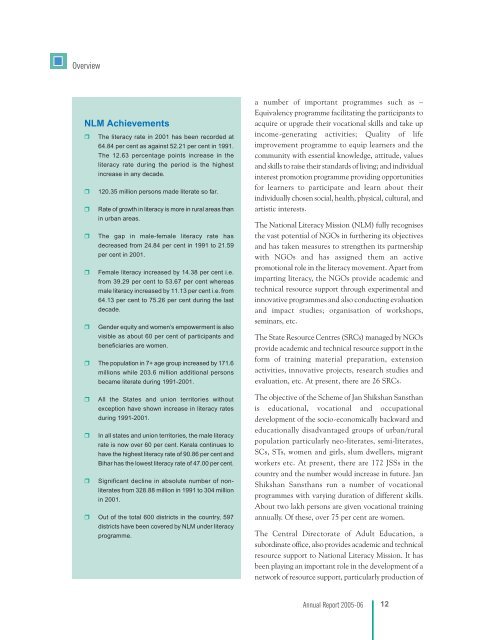all files - Azim Premji Foundation
all files - Azim Premji Foundation
all files - Azim Premji Foundation
Create successful ePaper yourself
Turn your PDF publications into a flip-book with our unique Google optimized e-Paper software.
Overview<br />
NLM Achievements<br />
r The literacy rate in 2001 has been recorded at<br />
64.84 per cent as against 52.21 per cent in 1991.<br />
The 12.63 percentage points increase in the<br />
literacy rate during the period is the highest<br />
increase in any decade.<br />
r 120.35 million persons made literate so far.<br />
r Rate of growth in literacy is more in rural areas than<br />
in urban areas.<br />
r The gap in male-female literacy rate has<br />
decreased from 24.84 per cent in 1991 to 21.59<br />
per cent in 2001.<br />
r Female literacy increased by 14.38 per cent i.e.<br />
from 39.29 per cent to 53.67 per cent whereas<br />
male literacy increased by 11.13 per cent i.e. from<br />
64.13 per cent to 75.26 per cent during the last<br />
decade.<br />
r Gender equity and women’s empowerment is also<br />
visible as about 60 per cent of participants and<br />
beneficiaries are women.<br />
r The population in 7+ age group increased by 171.6<br />
millions while 203.6 million additional persons<br />
became literate during 1991-2001.<br />
r All the States and union territories without<br />
exception have shown increase in literacy rates<br />
during 1991-2001.<br />
r In <strong>all</strong> states and union territories, the male literacy<br />
rate is now over 60 per cent. Kerala continues to<br />
have the highest literacy rate of 90.86 per cent and<br />
Bihar has the lowest literacy rate of 47.00 per cent.<br />
r Significant decline in absolute number of nonliterates<br />
from 328.88 million in 1991 to 304 million<br />
in 2001.<br />
r Out of the total 600 districts in the country, 597<br />
districts have been covered by NLM under literacy<br />
programme.<br />
a number of important programmes such as –<br />
Equivalency programme facilitating the participants to<br />
acquire or upgrade their vocational skills and take up<br />
income-generating activities; Quality of life<br />
improvement programme to equip learners and the<br />
community with essential knowledge, attitude, values<br />
and skills to raise their standards of living; and individual<br />
interest promotion programme providing opportunities<br />
for learners to participate and learn about their<br />
individu<strong>all</strong>y chosen social, health, physical, cultural, and<br />
artistic interests.<br />
The National Literacy Mission (NLM) fully recognises<br />
the vast potential of NGOs in furthering its objectives<br />
and has taken measures to strengthen its partnership<br />
with NGOs and has assigned them an active<br />
promotional role in the literacy movement. Apart from<br />
imparting literacy, the NGOs provide academic and<br />
technical resource support through experimental and<br />
innovative programmes and also conducting evaluation<br />
and impact studies; organisation of workshops,<br />
seminars, etc.<br />
The State Resource Centres (SRCs) managed by NGOs<br />
provide academic and technical resource support in the<br />
form of training material preparation, extension<br />
activities, innovative projects, research studies and<br />
evaluation, etc. At present, there are 26 SRCs.<br />
The objective of the Scheme of Jan Shikshan Sansthan<br />
is educational, vocational and occupational<br />
development of the socio-economic<strong>all</strong>y backward and<br />
education<strong>all</strong>y disadvantaged groups of urban/rural<br />
population particularly neo-literates, semi-literates,<br />
SCs, STs, women and girls, slum dwellers, migrant<br />
workers etc. At present, there are 172 JSSs in the<br />
country and the number would increase in future. Jan<br />
Shikshan Sansthans run a number of vocational<br />
programmes with varying duration of different skills.<br />
About two lakh persons are given vocational training<br />
annu<strong>all</strong>y. Of these, over 75 per cent are women.<br />
The Central Directorate of Adult Education, a<br />
subordinate office, also provides academic and technical<br />
resource support to National Literacy Mission. It has<br />
been playing an important role in the development of a<br />
network of resource support, particularly production of<br />
Annual Report 2005-06<br />
12

















